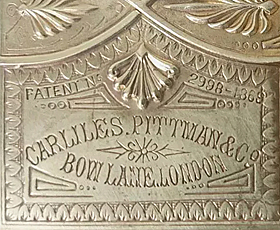Stella Golden

Needle Case

Patent (this patent number is stamped on the actual needle case)
Design Details
Needle Case Type: |
Flat-Names |
Patent/Registered to: |
William Avery - Redditch Manufacturer and Albert Fenton of the same place, Machinist |
Patent/Design Representation #: |
Mechanical Patent #: 2998 (Fig. 14) |
Patent/Design Registration Date: |
October 14, 1869 |
Location of Patent/Design Registration: |
British Library - Business and Intellectual Property Centre - London
|
Reference #: |
1869-2998 |
Dimensions: |
5.2 x 6.7 |
Material: |
Brass |
Name Variations: |
a) W. Avery & Son - Redditch
b) Baggallays, Westall & Spence - London
c) Carliles, Pittman & Co. - London
d) Hutton & Co. - London
e) D. Nicholson & Co. - London
f) Pratt & Farmer - New York
g) Charles Schleicher - Belle Valle |
Other Variations: |
Athena Golden |
Additional Photographs


Partially open and fully open


Name detail and Pratt & Farmer signature detail


Hutton signature detail amd Avery signature detail (photographs from eBay)


Schleicher signature detail (photo courtesy of Elaine Barnard-Brown) and Baggalays signature detail (photo from eBay)


Nicholson signature detail (photo from eBay) and cleaned signature detail

Carliles, Pittman & Co. signature detail.
Facts
Stella is the Latin (and Italian) word for star, a luminous point in the night sky. Although it was used as a feminine name in England as
far back as 1374, it wasn’t until the 19th century that is became common. After a thorough search we were unable to locate any famous Victorian
ladies named Stella who may have been the inspiration for the needle case with this name. However, what we did find was a bit of a surprise as
you’ll see in the history section below.

History

The most notorious Stella of the Victorian Era was the one arrested on April 28, 1870 in London. Frederick Park, age 23, and his friend
Thomas Boulton, age 22, were two cross dressing men who went by the names Fanny and Stella. They were well known in their circle for their
theatrical performances and the police suspected them of homosexuality. While in full drag leaving the Strand Theatre after attending a
performance with several gentlemen friends, they were arrested. Fanny and Stella were subjected to an intimate examination by the police in
an attempted to determine if a crime had been committed. The next day they appeared in court in full drag after a night in jail and became
the headline in all local newspapers. Stella’s “husband” Lord Arthur Clinton, a 29 year old aristocrat who served three years as a member
of Parliament, was included in the indictment and died of an apparent suicide the day after receiving his subpoena for the trial. Whenever
Fanny and Stella appeared in court during the subsequent trial crowds appeared to witness the spectacle as it shocked Victorian prudish sensibilities,
especially when their lifestyle was discussed and trunks full of women’s dresses were shown as evidence. The pair was eventually acquitted in
1871 when the prosecution failed to prove they had committed a homosexual act which at the time was a crime, and men wearing women’s clothing was
not an offense under British law. This reminds us of the story of Alan Turing the British mathematical genius who broke the Nazi Enigma code
during World War II enabling the Allies to defeat the Nazis in significant battles shortening the war. Turing was convicted in 1952 of a
relationship with another man and rather than going to prison accepted probation which consisted of hormonal treatments to change his sexual
orientation. He committed suicide in 1954. It wasn’t until 1967 that the UK decriminalized homosexual acts in private. Click on the
photographs of Fanny and Stella above and below to see a larger version of them.

Miscellaneous
One of the most popular Stella’s today is the beer known as Stella Artois. In 1717 Sebastian Artois purchased a brewery in the city of
Leuven, Belgium renaming the establishment the Artois Brewery. Over 200 years later in 1926 Stella Artois was launched as a festival beer
created as a Christmas gift for the people of Leuven. It was named Stella after the Christmas star. Once exported it became well-liked
and the company merged with other brewers around the world and today it is part of InBev, the world's largest brewing company. What makes
Belgium beer so special is each brand has its own unique glass in which only it is served. The Stella glass is an elegant chalice more like a
wine glass than a beer glass and as a result, is especially popular with woman.






















